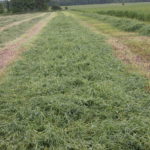
It can be very tempting to cut some alfalfa for haylage or baleage in the fall, particularly when supplies are tight or there is a lot of growth. The decision to cut or not needs to weigh the immediate need for forage against the increased risk of alfalfa winterkill and reduced yields next spring. How do we evaluate these risks?
Stressing Alfalfa Stands
Often in years when our alfalfa stands have been stressed to the limit, we ask them for more with a fall cutting. These stresses often go back to the previous fall and winter. Saturated soils in late fall, poor winter hardening, water ponding and ice sheeting can take their toll, as well as alfalfa crown and root diseases. As spring approaches, frost damage can delay and reduce growth. A dry April and May, and alfalfa weevil can also significantly reduced 1st-cut yields. A dry summer can result in poor 2nd- and 3rd-cut regrowth, with potato leafhopper taking an incredible toll, especially to new seedings.
Fall Cuttings and Reduced First-cut Yields
Cutting alfalfa during the fall can be a contributing factor to poor first-cut yields. Fall harvests are usually not very high yielding. These yields are typically offset by reduced vigour and lower first-cut yields the following spring. When we are faced with forage inventory shortfalls, it is understandable why some take the risk. However, we have been seeing more winterkill recently, even in areas where it is less common. Even where winterkill does not occur, stressed, weakened stands are at a greater risk of continued decline and poor yield. Digging some alfalfa crowns and roots and doing an assessment for disease and plant health can help in making fall cutting and rotation decisions.
Critical Fall Harvest Period
The Critical Fall Harvest Period for alfalfa is the 6-week rest period (450 Growing Degree Days) preceding the average date of killing frost. Not cutting during this period allows alfalfa plants to re-grow and build up sufficient root reserves to survive the winter and grow more aggressively in the spring. When cut, early in the period, the alfalfa will use the existing root reserves for regrowth, “emptying the tank”. Later in the period, the alfalfa uses photosynthesis to produce carbohydrates and stores them as root reserves, “refilling the tank”. Cutting in the middle, of the Critical Period (3rd or 4th week), when root reserves have been depleted and not yet replenished, is usually higher risk than cutting at either the beginning or end of the Period.
The Critical Fall Harvest Period begins as early as August 10th in northern Ontario, August 25 – 30th for eastern and central Ontario, and September 4th in the southwest (Figure 1). However, it is difficult to predict when that killing frost will actually occur. The actual date seldom occurs on the average date, so the beginning of the Critical Fall Harvest Period is a guideline only.
Figure 1. Start of the six-week alfalfa critical fall harvest period.
Even when winterkill does not occur, the extra yield harvested during the Critical Period is typically offset by reduced vigour and lower 1st-cut yields the following spring. It can sometimes be difficult to observe, but still be significant. Research shows that the yield sacrificed by not harvesting during the Critical Period is usually regained in first-cut yield the following year. We certainly saw this effect in the spring of 2012. The decision to cut should always be weighed against the immediate need for forage. If you do decide to cut, consider leaving some check strips that you can use for comparison next year.
Other Contributing Risk Factors
Fields with older stands, a history of winterkill, low potassium soil tests, low pH, poor drainage, or insect and disease pressure are at increased risk of winterkill and are poor candidates for fall harvesting. Aggressive cutting schedules with cutting intervals of less than 30 days between cuts increases the risk of winterkill, while intervals over 40 days (allowing flowering), reduces the risk. We frequently see fields with disappointing 1st-cut yields where 4th-cut was taken the preceding fall.
Some areas of the province, such as the Ottawa Valley, have a higher historical risk of winterkill. In situations where forage inventories are adequate, increasing the risk of winterkill by fall cutting is far less acceptable.
Late Fall Cuttings At The End Of The Critical Fall Harvest Period
If fall harvest must be done, risk of winterkill can be reduced (but not eliminated) by cutting towards the end of alfalfa growth, close to a killing frost. Little root reserves will be depleted by regrowth, but lack of stubble to hold snow to insulate the alfalfa crowns against damage during cold weather may be a problem. Increasing cutting height to 6 inches of stubble will help. Try to limit late cuttings to fields that are otherwise lower risk – well drained, good fertility, healthy crowns and roots, etc. A killing frost occurs when temperatures reach -4°C for several hours. After a killing frost, alfalfa feed value will quickly decline, as leaf loss occurs and rain leaches nutrients quickly.
Insufficient top growth and snow holding capacity can also contribute to alfalfa frost heaving. Stubble will protrude through winter ice sheeting, should that occur. Cut alfalfa initiates regrowth from crown buds and axillary buds, not the cut end of the stem, so cutting higher does not reduce usage of root reserves. However, cutting higher does allow for holding more snow as insulation.
Smothering?
There is always the question of smothering in heavy forage stands that are left unharvested. Heavy stands of grasses or red clover can sometimes smother over the winter because the top growth forms a dense mat. In contrast, alfalfa loses most of its leaves as soon as there is a hard frost, and the remaining stems remain upright and seldom pose any risk of smothering.
More Information
“Alfalfa Winterkill Risk Factors” (Factsheet 91-072) www.omafra.gov.on.ca/english/crops/facts/91-072.htm,

Comments are closed.